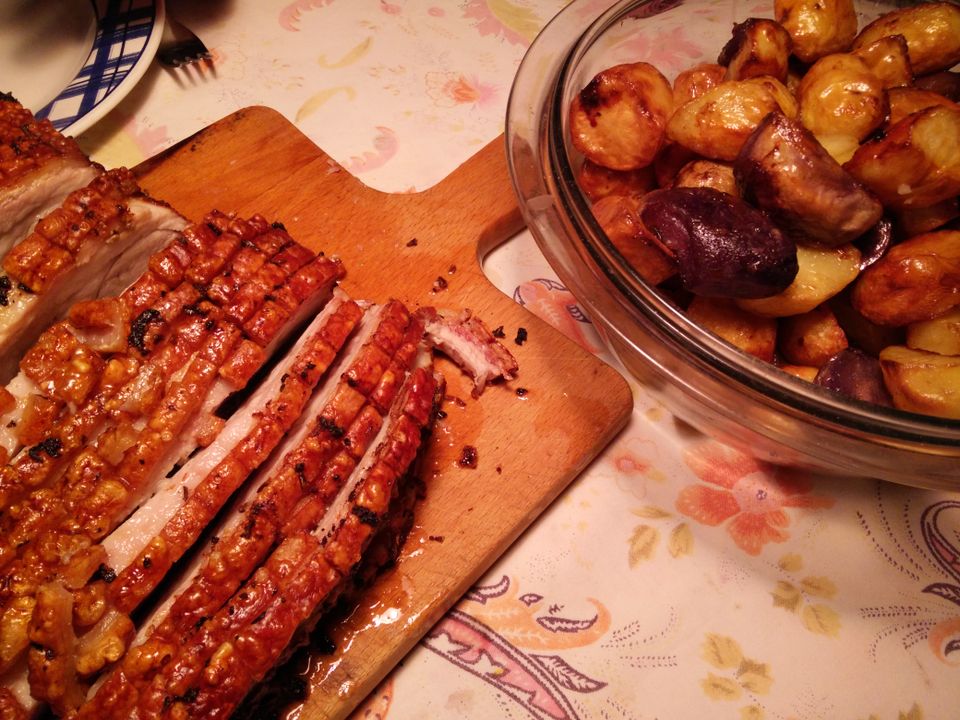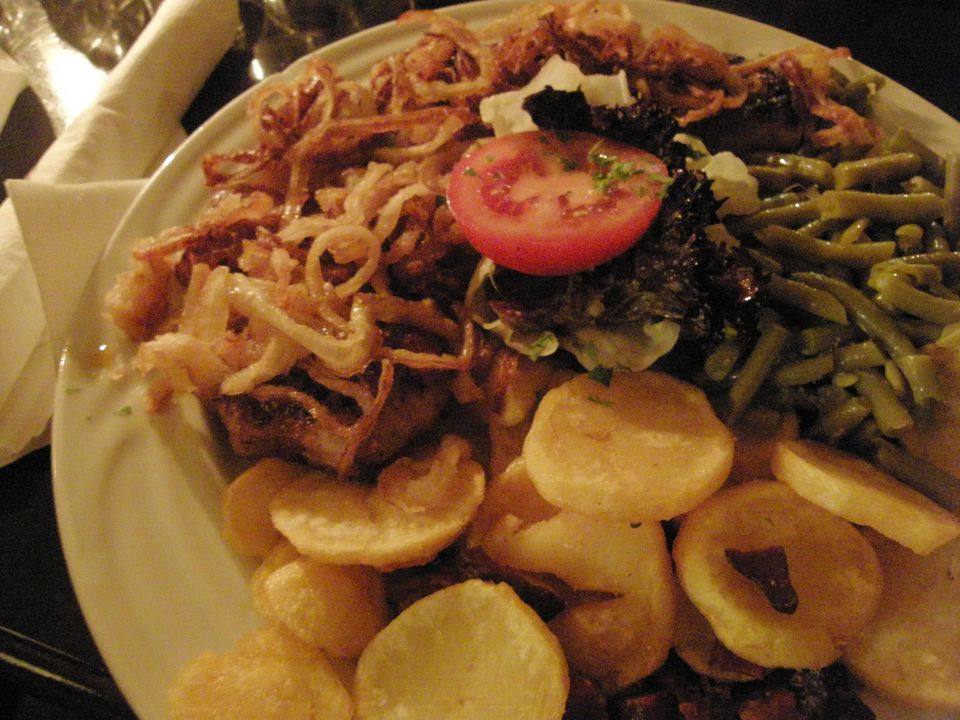I am what you might call a big fan of roast pork. I am such a big fan that I regularly eat and make roast pork. I’m such a big fan, that I usually eat so much of it until I’m ready to burst (or puke, actually, but since puking is hardly something to write about in your food blog, I decided to stick with “burst”). And after dinner, I usually sneak into the kitchen and eat leftovers, because as we all know, for every little peace of roast pork not eaten, God kills a little kitten. And who would want that?
Anyway, a visit to my parents’ on my birthday gave me the chance again to put into practice above described actions. You see, the recipe for the roast pork I usually eat is my father’s, so he still is the master of the roast pork. Well, here is my first plate (for aesthetic purposes, I made that photo before I loaded it with the actual number of pieces I usually eat on my first plate. Consider this an artsy representation of real food. You know, like nouvelle cuisine). And since this is a food blog and I’ve seen people post recipes on said food blogs, I’ll try myself at a recipe for above roast pork. Please note that you don’t need any kind of sauce or gravy. If done right, it’s going to be so juicy, it’ll squirt onto your shirt while eating. Promised!Well, here we go:
What you’ll need:
- Pork shoulder, with rind. This is very important, please reread that last sentence! Without rind, there won’t be any crust, and without crust you might as well go outside, collect a handful of dirt, put it in the oven and serve it as roast pork. So please, don’t forget the rind.
- Depending on the size of said shoulder, you’ll need somewhere between 8 and 12 garlic cloves. Don’t ask me why 8 and not 7 or 12 and not 13. In fact, I just pulled those numbers out of, well, somewhere. But I think you’ll be fine.
- Loads of caraway.
- Salt
And as a side-dish, I recommend
- potatoes
Actually, I don’t recommend but order you to make roast potatoes. If you object to the idea of roasting potatoes and pork, well, I won’t listen. Potatoes or bust, I say!
Preparation:
Pork:
First, peel those garlic cloves. Then use a garlic press to press them into a little bowl. When you’re done, and I promise you, your hands will be all garlicy, but you won’t mind, because you’ll have that fantastic roast pork in mind, generously pour salt and caraway into the bowl. Mix pressed garlic and all that other stuff until it’s a more or less coherent paste.
A note about the amount of caraway and salt: I don’t really know how much to use. It’s a feeling you develop after a while, so you may want to be rather careful with your first roast pork. If you haven’t used enough salt, you can always resalt. It won’t be as good, but you won’t have a too salty slab of meat sitting on your plate, screaming: “Why oh why did you use too much salt on me, I’m worthless now!”. Same holds true for caraway, by the way.
Take the pork, wash thoroughly (that’s what I always read in recipes, so I guess that’s the way to do it). Then put the slab on a board, get a sharp, a very sharp knife and cut the rind into a checkerboard pattern. Make sure not to cut through the rind, but don’t cut too superficially either, otherwise the crust won’t be crusty enough.
After you’re done, rub the paste into the meat. Make sure to rub it in good! Get it everywhere. You don’t need a whole lot of the paste on the rind, but do save some to disperse on those cute little cubes you cut out of the rind with your sharp knife.
Now, you’ve got the option of putting the whole thing into the fridge to let it sit there for a while. If you don’t want to wait, just put it into the preheated oven, somewhere round 200° C. Don’t put the roast onto a baking sheet, but rather on a tinfoil covered grill. You’ll learn why in a second.Let the heat grill the rind until it’s brown and starting to get all crusty, then cover the crust with tinfoil. Lower the heat a bit, maybe down to, say 180° C. Now all you have to do is wait, approximately an hour per kilo.
Potatoes:
When the roast’s in the oven, get those potatoes and peel them. You can then either pre-cook them, which of course dramatically shortens the time they would need in the oven. If you feel you don’t want to use yet another pot, then simply dump the potatoes, ideally cut into same size pieces, on a baking tray underneath the roast, about an hour before you think your roast will be done.
And here’s why I wanted you to put that roast on a grilling tray: Once you’ve got those potatoes in the oven, there’ll have accumulated lots of juice from the roast. Simply poke holes into the tinfoil surrounding the roast, and it will all pour down onto your potatoes, giving them a nice, porky and garlicy flavour. How’s that for frugal use of herbs and spices? The potatoes are done when they are crispy outside, hot and soft inside. Tada.
To check whether your roast is done, cut it in the middle and look at the juice. If it’s red, it’s not done. If it’s clear, it’s done and you can serve that mean, old bugger. No gravy needed.
Anyway, this recipe has become far too long and rambling and probably utterly useless for anyone who’d ever thought of actually making that roast. If you’ve still managed to make any sense of it and are planning on using it, do send me a message on how it went.

